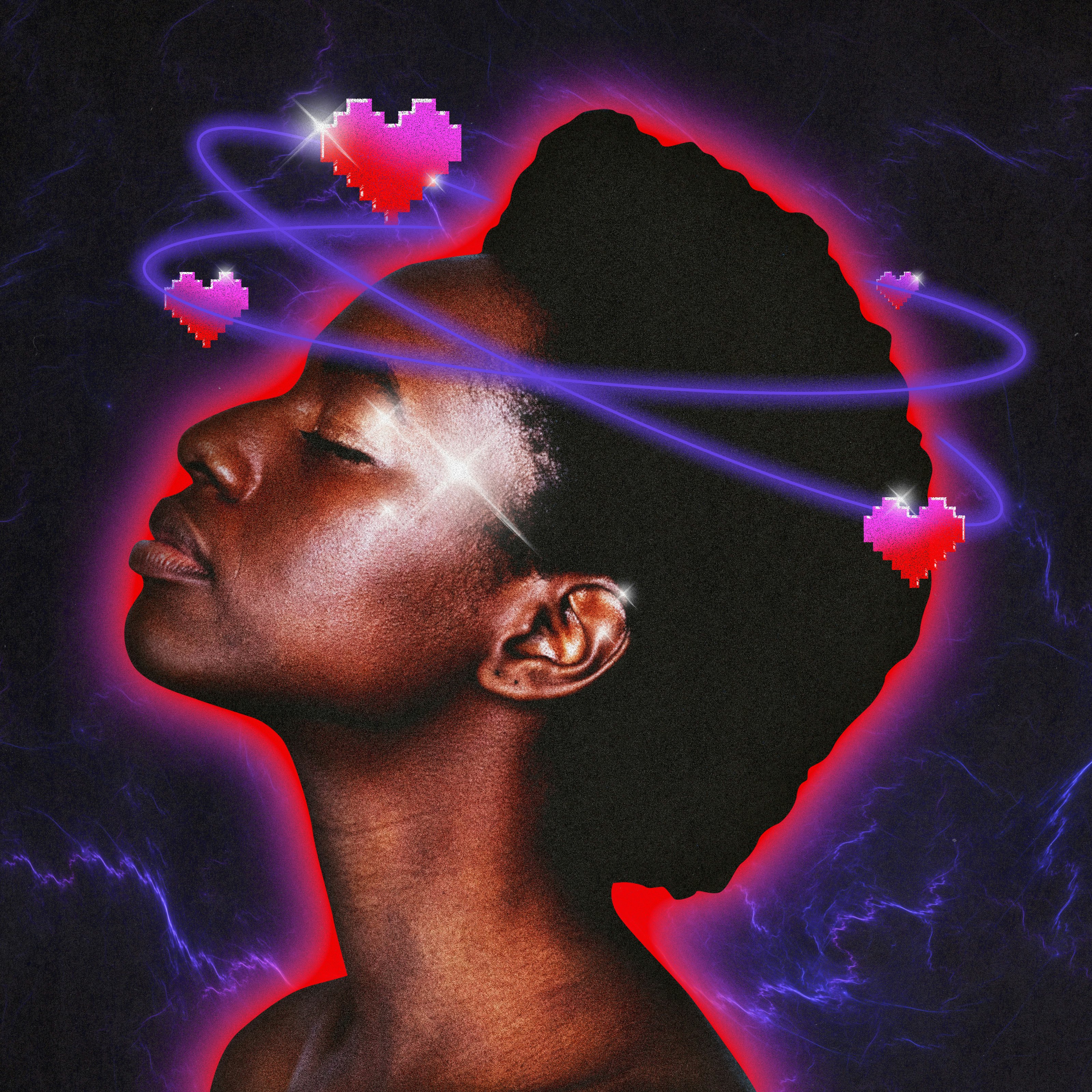
A skeptic might scoff that what we call “love” is actually a simple way to describe a complex chemical reaction humans evolved in order to survive. The main player in that reaction is a molecular Cupid’s bow called oxytocin.
The so-called “love hormone” has pulsed through living creatures for millennia. It is activated through all the handholding, stroking, caressing, hugging, kissing, and whatever else one might do to express their connection with a partner or even their child. The warm, fuzzy feelings these touches engender are the ties that reinforce familial bonds — a critical aspect of our survival as a species.
Yet new research into the neuroscience of touch brings oxytocin’s status into question — and opens up different avenues for potential discoveries about this funny little thing we call love. Humans are touchy-feely creatures: We primarily understand and express our social connections via touch. The sense is crucial for navigating the world. We process touch in the homunculus in the brain’s somatosensory cortex. Not all touches are felt equally. Neurons activated by stimulation to the mouth and hands take up most of the homunculus, suggesting that these body parts are more sensitive than others and perhaps more useful to us as we fumble through the world and with each other. If body parts’ size correlated to their sensitivity, humans would look something like this.
There are also different kinds of touch. Mechanical touch is that which discerns different objects. It’s the sense engaged when you’re digging through your bag to feel the cool smoothness of your phone or the leathery lump that is your wallet. Then there’s affective touch, which mediates relationships.
“Touch isn’t just for finding your keys in your pocket,” India Morrison, a neuroscience professor at Linköping University in Sweden, tells Inverse. “It’s also a medium for emotional sensation and communication.”
Affective touch triggers oxytocin. Morrison says even a gentle touch sends a signal to a part of the brain called the paraventricular nucleus, which sits within the hypothalamus, a region of the brain associated with basic bodily functions like thirst as well as emotion and sleep. In turn, the signal triggers oxytocin production in the pituitary gland and it releases the molecule into the bloodstream.
“There is a tendency to think of oxytocin as the love hormone,” Morrison explains. In other words, oxytocin may be thought of as the chemical analog for love. If that is true, then dosing people with oxytocin may ostensibly make the world a better — or at least a more sociable — place. “There’s a lot of proposals about therapeutic uses of oxytocin that just assume if you just give oxytocin to someone, the world will be wonderful.”
Oxytocin On Trial

There’s more to oxytocin than meets the eye.
Morrison is one of the authors on a recent study published to the preprint server Biorxiv — that means it is still to undergo a full peer review by a journal. In the study, Morrison and her colleagues recruited several heterosexual couples and performed magnetic resonance imaging (MRI) on the women in the lab. While the women were in the MRI machine, they received reassuring touches, in one instance from their partner and in another, from a stranger. Half the women experienced their partner’s reassuring caress first, and then the stranger’s touch. The other half experienced the same in reverse. The researchers also took blood samples from the women at different points during the experiment to measure oxytocin levels.
Here’s what they found: The women who were first touched by their partner had higher levels of oxytocin than those who felt a stranger’s caress first. What’s more, these women’s levels of oxytocin appeared to flatline in response to the stranger’s touch. When their partner touched them, oxytocin levels went up, but not to the same degree as the women who felt their partner first.
Morrison interprets the findings this way: “if you start out with a negative experience at the beginning of the day, then it really does affect your whole physiology and your receptivity to new experience.”
“For this particular kind of touch, time is not of the essence.”
On the other hand, starting your day with a hug from your favorite person could boost your oxytocin levels — and openness to new experiences.
Still, there is some research that flies in the face of the theory that oxytocin creates social bonds — at least in sexual relationships. Nirao Shah, a behavioral neuroscientist at Stanford University, used the gene-editing technology CRISPR to create genetically modified prairie voles that lacked oxytocin receptors. He wanted to see how voles would act without the love hormone coursing through their systems and whether they would still form bonds with prospective mates. The hypothesis driving this study, he tells Inverse, was that the modified voles wouldn’t form an attachment to their mate.
To Shah’s surprise, the modified voles — which Shah calls “knockout voles” because of the genes “knocked out” by the editing tool — behaved exactly the same as their unmodified counterparts when it came to courtship. Shah’s team published the experiment’s results in the journal Neuron in January.
“Knockout voles continued to form long term social attachments between sexual partners,” he tells Inverse. They “preferred to huddle with their own partner compared to a stranger animal of the opposite sex” and “aggressively rejected other potential sexual partners.”
But there was one behavioral change to note: The team observed that modified voles which went on to give birth seemed to produce less milk, in turn, fewer of their offspring survived and those that did were lower in weight than the offspring of unmodified voles.
“What the biology is telling us is that this receptor is not central to social attachment, at least from a genetic perspective,” Shah says.
So if it is not oxytocin that drives a romantic bond forward with touch, what is the biological fuel to the fire?
A Human Touch

Oxytocin may not be the be-all-and-end-all love hormone, but touch is still critical for fermenting deep social bonds — and not just any old touch will do. Three centimeters per second is the optimal speed at which to stroke someone’s skin, according to Manon Bohic, a neuroscience researcher at Rutgers University. A warm touch works best, too, she tells Inverse, but measuring tape, a stopwatch, and thermometer aren’t necessary to set the mood. Most humans learn how to touch one another the right way starting in infancy. Touch is also not necessarily better the more it’s applied — there’s a sweet spot. If you keep dragging a rigid, leaden — but warm! — hand across someone’s back, just see what happens.
But some rather more desirable things happen when a warm, welcome hand caresses the skin at three centimeters per second. First, this is the ideal speed to tickle nerves called C-tactile afferents, which detect the touch — but not just any touch. They relay the sensory signals through the spinal cord and up to the brain that we are being touched in a specifically gentle way that feels good.
C-tactile afferents were identified in 1999. These nerve pathways in the skin lack a fatty sheath known as myelin. Unmyelinated paths move at a phlegmatic rate of one meter per second.
“For this particular kind of touch, time is not of the essence,” Morrison says. “There’s time for leisure.”
Another way to look at the cellular highway here is that myelinated pathways are for urgent communication to the brain that require an express route. Unmyelinated pathways are the scenic route. This extended pathway, however, means more information than simply touch goes into this sensation. Morrison says unmyelinated routes tend to “chit chat” with other pathways a little more on the way up to the brain, allowing “more chance to integrate information from other sources.” A loving touch, after all, is more than registering three centimeters per second at a balmy temperature; it’s about who’s doing the touching, how you feel about that person in the moment, and how you feel the moment they touch you.
“If humans didn’t have C-tactile afferents, maybe social touch would be aversive.”
Curiously, C-tactile afferents are found in specific parts of the body. For one thing, they are only found in hairy skin. Each body hair follicle is rooted in a structure called a lanceolate ending.
“They make little fences around the base of the hair follicle to detect hair movement,” Kara Marshall, a neuroscience professor at Baylor College of Medicine, tells Inverse. “Hair movement is one kind of touch that can help you detect things like stroking or even a gentle breeze, or maybe even any little insect that's crawling on you might activate your touch receptors.”
But most crucially, C-tactile afferents are what register gentle touch, sending off that long, meandering, electrical impulse up an unmyelinated path to the brain.
Non-hairy, or glabrous, skin comprises our lips, palms, and the soles of our feet. Remember that the hands and lips are important for mechanical touch — and this is at least part of the reason why. Removing hair by shaving or waxing doesn’t get rid of lanceolate endings. But since body hair is sensitive to movement, C-tactile afferents in clean shaven skin may not detect pleasurable sensations as strongly as those on hairy skin.
A study in mice published in January in the journal Cell demonstrates just how much C-tactile afferents could mean to bonding. A team from the Zuckerman Mind Brain Behavior Institute identified analogous nerves in mice that allow them to feel gentle touch. After removing these corresponding nerves, female mice acted aggressively toward male sexual partners.
Though this is a mouse study, there’s reason to believe these results would extend to humans.
“If humans didn’t have C-tactile afferents, maybe social touch would be aversive,” Leah Elias, the study’s first author and a postdoctoral neuroscience fellow at Johns Hopkins University, tells Inverse. This insight aids not only in our understanding of social bonding, but disorders that inhibit it. “We can speculate and hypothesize that maybe some of these mechanisms in certain disorders where social touch is aversive, like autism spectrum disorder, is perceived differently for whatever reason.”
Ultimately, what all this tells us is that if you’re waiting for a chemical formula to explain the full biology of love and attraction before falling for someone, you will be waiting for an awfully long time. Thankfully, the beauty of love is that one doesn’t need a unified scientific theory in order to feel it. Whether you believe in love or attachment, soulmates or just mates, the desire to be understood or simply an instinct to survive, today is a great day to tell someone how much they mean to you — or to stroke their arm at three centimeters per second.
In The Future of Love, Inverse dives deep into the cutting edge science of pleasure, sex, and human connection — whether in virtual reality, the real world, or even space. Read the entire collection here.
Editor’s note: This story has been updated from the original to correct the title of a journal.







